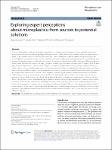Exploring expert perceptions about microplastics: from sources to potential solutions
| dc.contributor.author | Grünzner, M | |
| dc.contributor.author | Pahl, S | |
| dc.contributor.author | White, MP | |
| dc.contributor.author | Thompson, RC | |
| dc.date.accessioned | 2023-05-26T11:12:24Z | |
| dc.date.available | 2023-05-26T11:12:24Z | |
| dc.date.issued | 2023-04-11 | |
| dc.identifier.issn | 2662-4966 | |
| dc.identifier.issn | 2662-4966 | |
| dc.identifier.other | 7 | |
| dc.identifier.uri | https://pearl.plymouth.ac.uk/handle/10026.1/20937 | |
| dc.description.abstract |
Concern about plastic pollution, including microplastics, is high amongst European citizens, and effective actions are needed to reduce microplastic pollution. However, there is still uncertainty and debate about the major sources, impacts, and in particular the solutions. The aim of the current study was to gather expert perceptions about the risks of different microplastic sources to the natural environment and human health (measured as the likelihood and severity of negative impacts resulting from exposure), as well as the feasibility and effectiveness of different solutions. Experts were identified as scientists working on plastic. Usable responses were received from 73 experts with an average of 5 years’ experience in plastic research. Experts thought that there was currently stronger evidence for microplastic impacts on the natural environment than on human health, that, accordingly, the risks were higher, and they were more worried about impacts on the natural environment than on human health. Experts perceived tyre particles and textile fibres to be the main sources of microplastics presenting risk for both natural environment and human health. Various solutions were rated as relatively effective and feasible overall. Solutions that were rated as above-average in terms of effectiveness and feasibility included education and awareness programmes, washing machine filters, bans of plastic items, simplified design of products, and circular economy approaches. However, experts were uncertain about the effectiveness and feasibility of recovery and clean-up solutions, with overall ratings for these being below-average in comparison to other solutions earlier in the plastic life cycle. An improved understanding of expert views on these matters could inform the distribution of limited research resources and help prioritise research questions, especially with regard to potential solutions and interventions which will be critical for the success of the UN Plastics Treaty. | |
| dc.format.extent | 7- | |
| dc.language | en | |
| dc.publisher | Springer Science and Business Media LLC | |
| dc.subject | 41 Environmental Sciences | |
| dc.subject | 4105 Pollution and Contamination | |
| dc.subject | 14 Life Below Water | |
| dc.title | Exploring expert perceptions about microplastics: from sources to potential solutions | |
| dc.type | journal-article | |
| plymouth.issue | 1 | |
| plymouth.volume | 3 | |
| plymouth.publication-status | Published online | |
| plymouth.journal | Microplastics and Nanoplastics | |
| dc.identifier.doi | 10.1186/s43591-023-00055-5 | |
| plymouth.organisational-group | |Plymouth | |
| plymouth.organisational-group | |Plymouth|Research Groups | |
| plymouth.organisational-group | |Plymouth|Faculty of Science and Engineering | |
| plymouth.organisational-group | |Plymouth|Faculty of Science and Engineering|School of Biological and Marine Sciences | |
| plymouth.organisational-group | |Plymouth|Research Groups|Marine Institute | |
| plymouth.organisational-group | |Plymouth|REF 2021 Researchers by UoA | |
| plymouth.organisational-group | |Plymouth|Users by role | |
| plymouth.organisational-group | |Plymouth|Users by role|Academics | |
| plymouth.organisational-group | |Plymouth|REF 2021 Researchers by UoA|UoA07 Earth Systems and Environmental Sciences | |
| plymouth.organisational-group | |Plymouth|Users by role|Researchers in ResearchFish submission | |
| dcterms.dateAccepted | 2023-03-17 | |
| dc.date.updated | 2023-05-26T11:12:24Z | |
| dc.rights.embargodate | 2023-5-27 | |
| dc.identifier.eissn | 2662-4966 | |
| dc.rights.embargoperiod | forever | |
| rioxxterms.versionofrecord | 10.1186/s43591-023-00055-5 |


